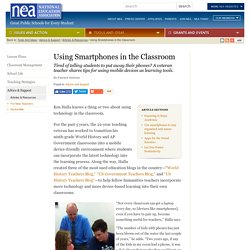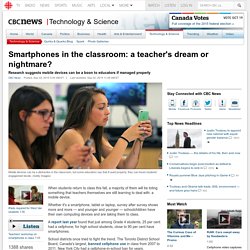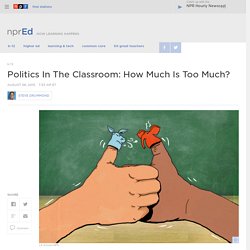

Integrating technology in the classroom. Studies show that students succeed with digital learning, but making the transition from text book to tablet has its challenges.

As students across the country dive into a new school year, ready to hit the proverbial books, many find themselves swiping screens instead of flipping pages as districts ramp up tech programs. Laptops, tablets, software and apps. These are the tools of learning in the 21st century, the paper and ink of the next generation. These essential skills include communication, critical thinking, problem solving, collaboration, and, of course, digital literacy.
33 Digital Tools for Advancing Formative Assessment in the Classroom. I came across a great blog post the other day – Formative Assessments Are Easier Than You Think – that told the firsthand account of a teacher, Steven Anderson, who implemented formative assessment in his classroom.

He used a sticky-note version of an exit ticket to elicit evidence of student learning and in his words, “what a difference that made.” Formative assessment is ‘easier than you think’ and with all the digital tools and apps now available for mobile devices it’s even easier. We’ve shared some digital tools before and with the five tools that Steven shared combined with our earlier suggestions there are now 33 digital tools that we’ve uncovered that are free or inexpensive and help teachers implement formative assessment in their classrooms. Here they are: A few of Steven’s discoveries: Using Smartphones in the Classroom. By Edward Graham Found in: Advice and Support Ken Halla knows a thing or two about using technology in the classroom.

For the past 5 years, the 22-year teaching veteran has worked to transition his ninth-grade World History and AP Government classrooms into a mobile device-friendly environment where students can incorporate the latest technology into the learning process. Along the way, Halla created three of the most used education blogs in the country—“World History Teachers Blog,” “US Government Teachers Blog,” and “US History Teachers Blog”—to help fellow humanities teachers incorporate more technology and more device-based learning into their own classrooms.
“Not every classroom can get a laptop every day, so [devices like smartphones], even if you have to pair up, become something useful for teachers,” Halla says. How and Why to Start Blogging in the Classroom. What does blogging in the classroom look like?

Generally the teacher sets up a main page, and initially writes the main content of the blog, allowing and encouraging kids to comment. As kids show the appropriate skills in commenting, they eventually get to write and publish their own blogs within the class blog. What are different kinds of blogs out there? Smartphones in the classroom: a teacher's dream or nightmare? Another CBC News Story. When students return to class this fall, a majority of them will be toting something that teachers themselves are still learning to deal with: a mobile device.

Whether it's a smartphone, tablet or laptop, survey after survey shows more and more — and younger and younger — schoolchildren have their own computing devices and are taking them to class. A report last year found that just among Grade 4 students, 25 per cent had a cellphone; for high school students, close to 90 per cent have smartphones. School districts once tried to fight the trend. 10 Tips For Smarter iPad Use In The Classroom. Unlocking The Learning Potential Of The iPad by Terry Heick The iPad.

Pop culture’s plaything and #edtech’s (somewhat dimming?) Neon sign. It’s an app library, a media consumption device, and a mobile learning tool that makes yesterday’s graphing calculators, smartboards, and laptops look like abacuses. Coding in the Classroom: 16 Top Resources. As cool as technology is, its intricacies and inner workings are sometimes intimidating, especially for young people who may be more interested in what technology can do for them rather than what they can do with technology.

However, when students hurdle that obstacle and see the value of computer science — specifically coding — they gain a broadened perspective and the potential for a rewarding career in the tech field. The following resources will help you teach your students the basics of coding and will provide tips on how to keep kids interested as you go. Tools to Use in Class. 5 Simple Ways To Add Movement In The Classroom. Politics In The Classroom: How Much Is Too Much? : NPR Ed. The Confederate flag.

The Supreme Court ruling on gay marriage. Policing minority communities. Nuclear weapons and Iran. 10 Ways to use Instagram in the classroom. Instagram isn’t just a platform for selfies, business promotions, and cute animals.

With a little creativity, you can bring the visual power of photos and videos to your classroom, weave them into your students’ learning process, and bring a little fun to their (and your!) Days. 33 Digital Tools for Advancing Formative Assessment in the Classroom. I came across a great blog post the other day – Formative Assessments Are Easier Than You Think – that told the firsthand account of a teacher, Steven Anderson, who implemented formative assessment in his classroom.

He used a sticky-note version of an exit ticket to elicit evidence of student learning and in his words, “what a difference that made.” Formative assessment is ‘easier than you think’ and with all the digital tools and apps now available for mobile devices it’s even easier. Terrific Tales of Teachers and Twitter in the Classroom. Let’s have an honest discussion about Twitter and teachers. What makes Twitter a tool that teachers would want to use? How have teachers already used Twitter? What’s the honest feedback? There’s no better place to look than at examples of success with Twitter’s practical applications in the modern classroom. Let us pay tribute to those who have bravely blazed the trail before us. iPads in the Classroom: The Right Questions You Should Ask.
The pressure is on to make sure the education of U.S. students is on track with their global peers. Unfortunately, according to a 2015 report by Pew Research Center, that’s not the case, particularly in the areas of science and math. It’s no wonder, then, that in the quest for educational advancement, teachers want their students to have access to the newest, theories, processes and technologies to help the students excel. One of the most popular technologies has been the introduction of tablets, particularly, iPads, in the classroom. Maybe you’ve been thinking about augmenting your program with iPads or another type of tablet.
But before you and your school make a hefty investment of finances and time, consider these questions to ensure this technology is right for your purpose. Terrific Tales of Teachers and Twitter in the Classroom. 100 Ways To Use Google Drive In The Classroom. 12 Unexpected Ways to Use LEGO in the Classroom. LEGO Bricks are toys. They’re items that students willingly seek out to play with and get excited to receive as gifts under the Christmas tree. That’s one of the things that make them so useful to teachers. Lessons taught using LEGO Bricks don’t feel like dull schoolwork. On the contrary, students might feel like they’re getting away with something. Resources to teach coding in the classroom. Coding in the Classroom: 16 Top Resources. Inquiry in the Classroom: 7 Simple Tools To Get You Started. We know certain characteristics can be encouraged, but not taught, like curiosity. But teachers who use an inquiry based approach can provide techniques that help students learn the questions to ask that may spark a natural interest.
Image from Flickr via David Woo Why Use the Inquiry Cycle? Often used by science professionals to work through problems and research, an inquiry-based approach, or inquiry cycle, is also used in classrooms for scientific and non-scientific topics to encourage students during the learning process. The Center for Inspired Teaching, an organization that provides teacher training, explains that in an inquiry-based approach, teachers help students generate their own appropriate questions and guide the investigation. An Epic Guide to Student Engagement in the Classroom. When I first saw this infographic (created by Dr.
Roland Rios) based on Schlechty’s Levels of Engagement, it actually took me a moment to collect my thoughts. I quickly asked myself, “What the heck does student engagement even mean?” How Teachers Make Cell Phones Work in the Classroom. Do mobile devices in the classroom really improve learning outcomes? #edtechbc. How Video Games In The Classroom Will Make Students Smarter #edtechbc. 12 Tips to Manage Time and Increase Efficiency in the Classroom! A Brief History of Calculators in the Classroom (From the days when they were banned) 60 Ways to Use Twitter in the Classroom by Category. 7 Tips For Getting Started With Mindfulness In The Classroom. Social Media in the Classroom: 16 Best Resources for 2015. 80 plus ideas for using iPad in the classroom #appaday.
Print & Play Games: Games For Use In The Classroom. Using Digital Tablets: Technology in the Classroom. "What Does Awesome Look Like?" A Free Teacher Activity Book for iPads in the Classroom #edtechbc. How Twitter in the Classroom Connects Your Students. How to Use Crowdsourcing in the Classroom.
7 Ways to Use Digital Photography in The Classroom. How to Use Social Media as a Learning Tool in the Classroom. 8 EdTech Hacks: A Cheat Sheet for Interactive Classroom Collaboration.